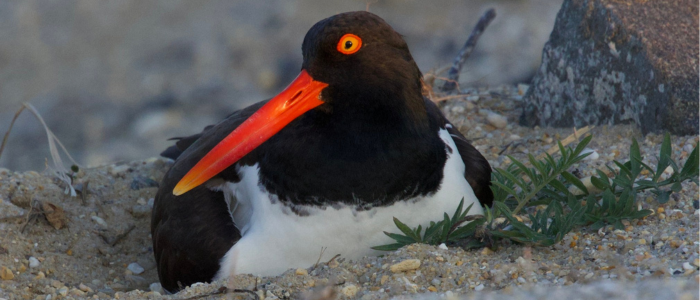
By Alison Mitchell
Executive director, New Jersey Conservation Foundation
Have you ever spotted a striking bird with a bright orange-red bill and a loud, laughing call on the beach? That’s the American oystercatcher. A captivating shorebird native to New Jersey, the species was declining for years, but now it seems the population could be making a modest comeback.
It’s a rare piece of good news for coastal wildlife, and a sign that long-term conservation efforts may be paying off. But scientists caution against declaring victory too soon.
“Yes, we’re seeing an increase,” says Todd Pover, senior wildlife biologist at Conserve Wildlife Foundation of New Jersey. “But it’s a little bit complicated.”
Formal monitoring of oystercatchers began in the early 2000s on oceanfront beaches, where researchers initially counted about 50 nesting pairs. That number has grown to about 150. Many oystercatchers also nest in back bays and other hard-to-reach areas, so the true population size in the state remains uncertain.
That tripling of numbers is encouraging, but Pover notes some of it may be due to improved monitoring and the addition of new survey sites over time. Still, it is good to know that there are more pairs than we thought. And data suggests at least part of the rise is genuine and likely linked to conservation efforts.
“We’re not just monitoring them,” he says. “We’re also protecting them.”
Like other shorebirds, oystercatchers benefit from seasonal fencing and restricted access to sensitive nesting areas. Municipalities work with wildlife agencies on beach management plans that reduce threats from recreational traffic, maintenance vehicles, and human disturbance.
Conservation efforts are especially crucial during nesting season. American oystercatchers typically arrive in New Jersey in March and begin nesting in April, continuing through mid-summer and wrapping up by July.
Their southward migration generally occurs later in the year, with final flights taking off in mid-November. This means that in late summer and early fall, you might spot big groups scurrying along the beach together before they head south for the winter.
Oystercatchers are unusually charismatic. Large and boldly-colored, they have vivid orange and yellow eyes, dramatic black-and-white plumage and unmistakable calls that make them easy for beachgoers to observe and adore.
The oystercatcher’s biology gives them another advantage. While chicks from birds like piping plovers feed themselves along the water’s edge near humans and beach vehicles, oystercatcher parents deliver food to their young. That difference gives oystercatchers a slight survival edge on busy beaches.
Oystercatchers also nest in marshes and even on rooftops, which reduces their reliance on a single habitat and increases their chances for success. Yet, while they continue to make gains, the birds face growing uncertainties brought on by a changing climate and habitat loss. A recently observed shift in some of their nesting sites may be driven by habitat loss, showing how small gains can be quickly offset by bigger challenges.
Nationally, oystercatchers are considered at risk. The 2025 “State of the Birds” report named them among 19 North American shorebird species vulnerable to extinction. In New Jersey, they’re listed as a species of special concern – not yet endangered, but not safe either.
Luckily, these impressive birds have a wide network of support. The American Oystercatcher Working Group is a coalition of researchers and organizations across the Atlantic and Gulf Coasts that has coordinated conservation conservation strategies and shared data for over two decades. Alongside the working group, Conserve Wildlife Foundation, the state Endangered and Nongame Species Program, and local partners have joined together to protect the species.
To support the American Oystercatcher Working Group, visit https://amoywg.org.
